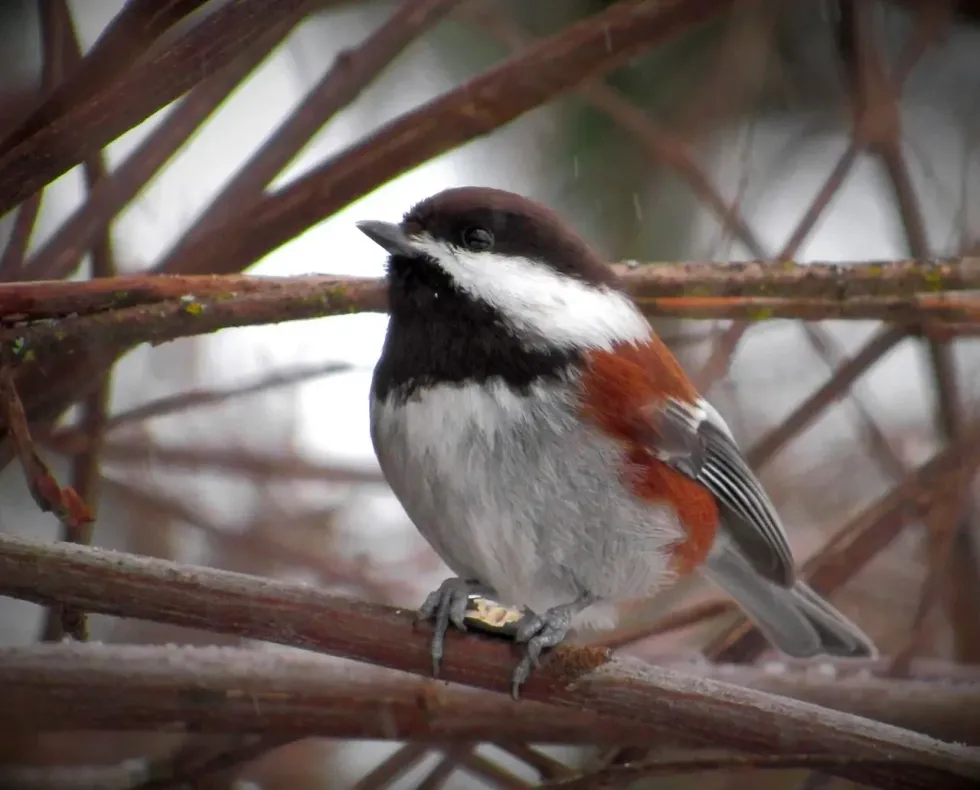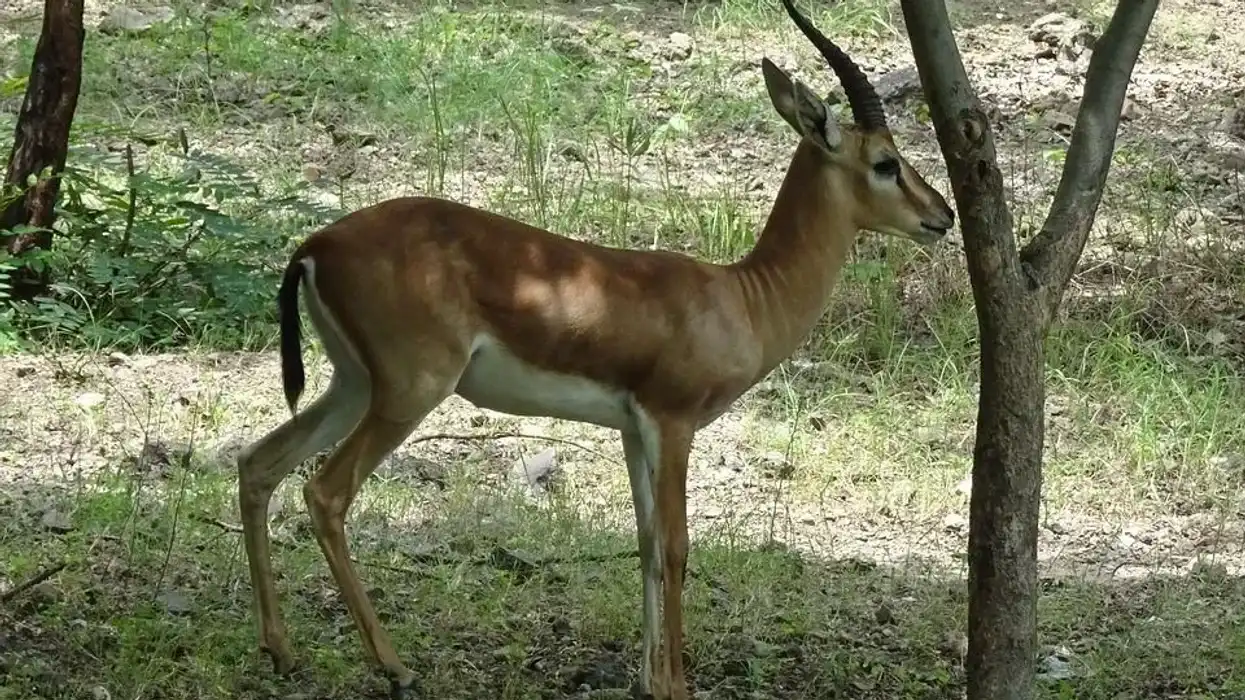Have you heard of Chickadees - famous North American birds? Chickadees look similar to Nuthatches as they are similar in size, covering many of the same habitats, and are preyed upon by the same predators as they live in mixed flocks.
Their name comes from the distinctive 'chick-a-dee-dee-dee' call they make.
Now let us know about one of its species, the Chestnut-backed chickadee (Poecile rufescens), which is often regarded as the most appealing in them. Apart from this, they are the smallest birds and are extremely adaptable.
Chestnut-backed chickadees have a back and flanks in chestnut color with white cheeks and black bib. Three subspecies can be distinguished by their chestnut or rufous color on their flanks.
The first one is the Poecile rufescens rufescens, which range from Alaska south to northwest California, and has a wide rufous band on the flanks.
The second species is Poecile rufescens neglectus, found in coastal Central California and has a narrow rufous band on its flanks. The third species is Poecile rufescens barlowi, a habitat of coastal southwestern California, which has almost no rufous color on the flanks.
If you enjoy reading about Chestnut-backed chickadees, have a look at the articles on birds of paradise and barn owl articles to learn more about other birds.
Chestnut-Backed Chickadee Interesting Facts
What type of animal is a Chestnut Backed Chickadee?
The Chestnut-backed chickadee is a passerine bird from the family of Paridae. They are small songbirds with the crown of the head and throat patch being noticeably darker than the rest of the body.
What class of animal does a Chestnut Backed Chickadee belong to?
The Chestnut-backed chickadee (Poecile rufescens) are birds that belong to the class Aves.
How many Chestnut-Backed Chickadees are there in the world?
As per the Cornell Lab of Ornithology, the global breeding population of these birds is 9.7 million, with 64% living in the United States and 36% in Canada.
Where is Chestnut Backed Chickadee found?
The Chestnut-backed chickadee birds range through the Pacific Northwest forests of the United States and Western Canada, extending from Central California to South-Central Alaska.
What is a Chestnut-Backed Chickadee's habitat?
Chestnut-backed chickadees primarily inhabit the low elevation of dense, deciduous forests and wet coniferous forests. They're also frequently seen at backyard feeders in urban, suburban, and rural areas with plenty of trees and shrubs. These birds construct their nests with mature coniferous trees, especially cedars, pines, and hemlock trees.
Who do Chestnut-Backed Chickadees live with?
Instead of competing for limited resources, Chestnut-backed chickadees join mixed feeding flocks and are frequently seen with bushtits and warblers in large groups.
How long does a Chestnut-Backed Chickadee live?
While the life span of a Chestnut-backed chickadee is about four years, the oldest Chestnut-backed chickadee registered was at the age of nine years and six months, according to a study conducted by Cornell Lab of Ornithology in California.
How do they reproduce?
Chestnut-backed chickadees freely join mixed-species flocks, but during the breeding season, they become territorial. Their Breeding season starts in winter around mid-March or early April.
After mating females lay six to eight eggs on average but can go up to 11 eggs, their eggs are white with reddish to light-brown spots. Both the parents incubate for about 12-14 days and feed chicks for 18-21 days after hatching. These young ones reach their sexual maturity after one year.
What is their conservation status?
According to a bird survey by Cornell Lab of Ornithology, the conservation status of these species is Least Concern at this moment, as these birds are common throughout their range.
Chestnut-Backed Chickadee Fun Facts
What do Chestnut Backed Chickadees look like?
The Chestnut-backed chickadee is a small energetic bird. These birds look much like Black-capped chickadees, but the caps are not black but brown. Their head is dark blackish-brown with white cheeks, the mantle is bright rufous-brown, and the wing feathers are dark gray with paler fringes. The underparts are white to pale grayish-white, with rufous or pale gray flanks.
How cute are they?
These birds are cute to watch with their chestnut-brown back, rump, and flanks due to their overly large round head, tiny body, and curiosity about everything. You will love to watch these birds hopping along the branches of the trees and select surfaces, and search cleaves to find food.
They are often seen hanging upside down on the bottom of the branches to get food.
How do they communicate?
These birds communicate information on the identity and recognition of other flocks and a predator by making their 'chicka-dee-dee' call. The greater the 'dee' notes in the call means they are at a higher threat level.
This call is a high, thin, scratchy 'chick-a-dee' that lasts 1-1.5 seconds. Chestnut-backed chickadees do not have the clear-whistled fee-bee song that most other chickadees do. Instead, they have a series of gargle calls.
How big is a Chestnut-Backed Chickadee?
Chestnut-backed chickadees are the smallest chickadees that grow 4.5-4.9 in (11.5–12.5 cm) long and are smaller than a sparrow.
How fast can a Chestnut-Backed Chickadee fly?
The speed of the Chestnut-backed chickadee has yet to be determined. It would, however, be within the chickadee's flight speed range from 12-13 mph.
How much does a Chestnut Backed Chickadee weigh?
This tiny bird's weight ranges from 0.3-0.44 oz (8.5-12.6 g).
What are the male and female names of the species?
There is no specific terminology given to denote a male and female Chestnut-backed chickadee.
A male and a female Chestnut-backed chickadee have the same plumage. However, it is observed that female birds have shorter wing chords, tails, and tarsus than male birds.
What would you call a baby Chestnut-Backed Chickadee?
A baby Chestnut-backed chickadee is referred to as a chick.
What do they eat?
They primarily consume insects and other arthropods such as caterpillars, spiders, some tiny-scale insects, leafhoppers, aphids, and wasps. They primarily feed caterpillar and wasp larvae to their young ones. Their diet also includes seeds and fruit, particularly those from conifers. These birds enjoy suet when they visit bird feeders.
Are they aggressive?
These birds are not known to be aggressive. If they feel threatened, however, they can defend themselves and are known to make a 'dee-dee-dee' call when feeling any aggression.
Would they make a good pet?
These are playful and very friendly birds that will surely make them good pets.
Did you know...
The Chestnut-backed chickadee and Boreal chickadee have the same look, except for the brown heads of the Boreal chickadee and the dark heads of the Chestnut-backed chickadees.
How long does a Chestnut-Backed Chickadee build a nest?
While a male bird chooses the location, the female builds the nest. Their nests are made of lots of fur and hair.
They make a bottom layer with moss and strips of bark, particularly incense cedar when it’s available. The nest’s upper layer consists of animal fur woven with strips of bark, feathers, grass, and sometimes textile fibers too. Their nest is usually made from deer, rabbit, goat, coyote, cat, skunk, and cattle hair.
The adult chickadees make a centimeter-thick layer of fur and hair to hide the eggs in the nest when they are away. This nest building takes about seven to eight days.
What is the scientific name for Chestnut Backed Chickadee?
The scientific name of the Chestnut-backed chickadee is Poecile rufescens.
Here at Kidadl, we have carefully created lots of interesting family-friendly animal facts for everyone to discover! Learn more about some other birds from our secretary bird facts and great green macaw fun facts pages.
You can even occupy yourself at home by coloring in one of our free printable chestnut-backed chickadee coloring pages.










